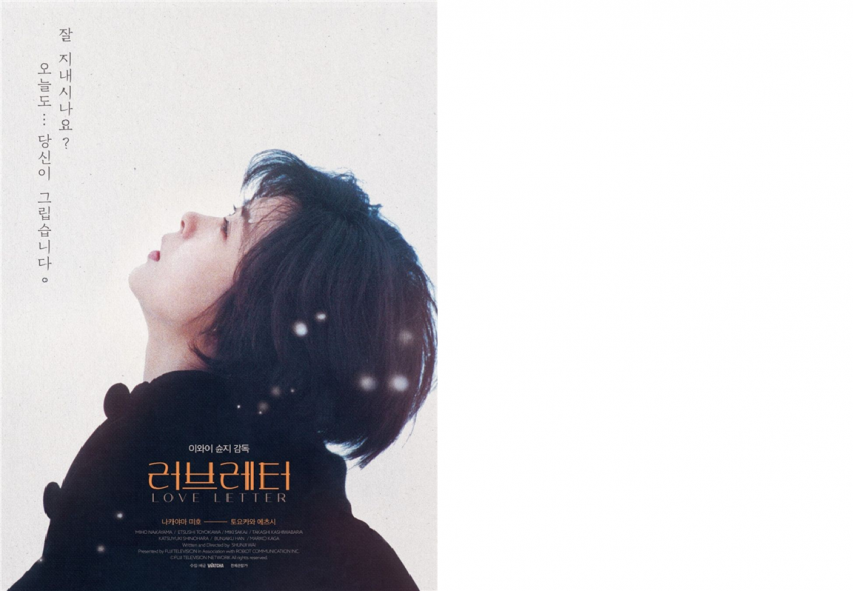In recent years, re-released films have been gaining significant traction in the film industry. According to the Korean Film Council, 84 films were re-released in 2024, nearly double the 48 re-release from 2023. These films incorporate advanced technology and innovative marketing strategies to provide audiences with a fresh experience, reshaping the culture of movie-watching.
How Re-Released Films Are Winning Over Audiences
Re-released films are not merely bringing past works back to the screen; they are becoming a new box office phenomenon. Iwai Shunji's Japanese melodrama “Love Letter”, which gained immense popularity after its release in late 1999, was re-released on New Year's Day 2025 to mark its 25th anniversary. On its first day back in theaters, it attracted 14,957 viewers and achieved a seat occupancy rate of 42%. This record is higher than most new releases, demonstrating the competitiveness of re-released films. Additionally, the re-release fully restored vertical subtitles from its first screening in Korea in 1999 and corrected previous mistranslations in the Japanese subtitles, enhancing its overall quality and garnering positive audience feedback.
“The Fall: Director’s Cut”, which underwent a 4K remastering after 16 years, was re-released in December last year. Despite a limited release in 66 theaters nationwide and only 15,025 available seats on its opening day, the film maintained long-term success thanks to a dedicated fan base and strong word-of-mouth. By February 4, in its seventh week of re-release, the film surpassed 100,000 cumulative viewers, proving its steady popularity. Other re-released hits include “Begin Again”, “Better Days”, and “The Notebook” each attracting around 200,000 viewers, reaffirming their strong demand.

The poster of "Love Letter"
Photo by Waterhole Company (waterholecompany.net)

The poster of "The Fall"
Photo by AUD (facebook.com/audcine)
Why Are Re-Releases Thriving?
The growing popularity of re-released films stems from changes in audience movie consumption habits, cross-generational appeal and strategic responses from the film industry. Following the pandemic, the rapid growth of online streaming services, over-the-top (OTT), has led audiences to be more selective about which films they watch in theaters. As a result, rather than taking risks on new releases, theaters have opted to re-release previously successful films, providing audiences with proven classics. Film critic Lee Ji-hye noted that recent Korean films lack original storylines and rely too much on computer graphics and sensational elements, making it harder for audiences to connect emotionally. In contrast, she explained that older films explore diverse themes and deeper storytelling, making them more appealing than contemporary movies.
In addition, re-released films bridge the generational gap. “University students, who rarely encounter nostalgic romance and retro love stories in modern cinema, are experiencing them through re-released films.” said Lee. "This growing interest is driving the demand for re-releases." Technological advancements have also revitalized older films. With improvements in video restoration technology, older films are being reborn with sharper visuals and enhanced sound quality, attracting audiences back to theaters. Lee stated, "Re-released films are not merely restorations. They serve as cultural bridges connecting the past and present." She further explained, "As digital platforms evolve, the fusion of past cinematic sensibilities with modern visual enhancements is making older films feel new again."
The Future of Re-released Films
As restoration technology and audience demand evolve, re-released films are expanding beyond traditional re-screenings. Recently, the selection criteria for re-released films have shifted beyond past box office performance, with increasing emphasis on fan base potential and marketability. Lee explained that when selecting films for re-release, distributors consider not only their original box office performance but also their relevance to modern audiences.
The value of re-released films is also increasing as they integrate with technological advancements. Films originally shot on film stock are being digitally enhanced with 4K remastering and Artificial Intelligence-powered super-resolution technology. Some re-releases are even screened in IMAX and 4DX formats, offering a fresh cinematic experience. With these technological improvements, re-released films go beyond simple restorations and are presented to audiences with a modern sense.
Beyond screenings, re-released films are expanding to offer interactive experiences such as merchandise sales, special screening events, and Guest Visit (GV) programs where audiences engage with filmmakers. For example, “Love Letter” offered limited-edition postcards and posters featuring key scenes to audiences during its re-release, while “The Fall: Director’s Cut” hosted GV sessions where the director shared insights into the film’s creative vision. These strategies boost engagement and attract new audiences, helping older films compete in the modern market.
This strategy not only enhances audience interaction with the films but also helps attract new fan bases. Theaters and streaming platforms are increasingly working together. Lee said, “Major OTT services like Netflix, Watcha, and Disney+ are likely to adopt a model of exclusively streaming re-released movies simultaneously with their theatrical releases.” She analyzed, "Previously, re-released movies were limited to simple restoration screenings, but now they are expanding into digital-exclusive content through collaboration with OTT services." This hybrid approach is expected to diversify distribution methods, allowing classic films to reach wider audiences. In this way, as OTT platforms and theaters collaborate in a complementary manner, the distribution methods for re-released movies are expected to become more diverse.
Despite the current success of re-released films, their long-term sustainability remains uncertain. Lee predicted, "While re-released movies are currently gaining attention, this is likely a temporary trend aimed at overcoming the stagnation in the film industry, and there is a high possibility that it will change into new content or methods in the future." However, the theater industry views re-released movies as an independent content market, and there is a strong possibility that attempts will be made to incorporate the latest technologies.
Re-released films are no longer just nostalgic throwbacks–they are being reborn through cutting-edge restoration, immersive formats, and innovative marketing strategies. With collaboration between theaters, OTT platforms, and fan communities, the audience base is expanding even further. While it remains to be seen whether this trend will last, one thing is clear: old favorites are finding new life on the silver screen, proving that some stories never fade.



